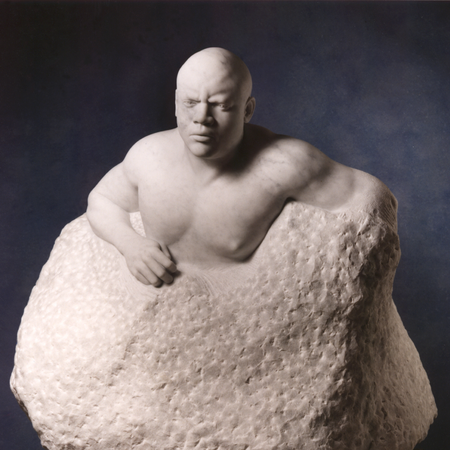ReThink Collection
1989: Emerging Continents
1989: Emerging Continents, reflects a turbulent period in our history, the global events of 1989 in divided Germany, the Tiananmen Square massacre, Beijing China, and in South Africa inspired these figures emerging from or trapped by, the stone that represents their history and echoes their future.
This work speaks of some of the trauma being experienced in Europe, Asia and Africa, their portraits depicting repression and rebellion, thus contemplating the distinction between treason and revolution.
The portrait of the young oriental man expresses the compassion and solidarity for the victims of oppressive governments in China. The African, emerging from the marble block clutching the "stone" from the wall represents liberation and hope for the future in South Africa.
The work was created in 1990 in marble thanks to a friend and patron Mr. Teddy Field to whom I owe my most sincere gratitude for his trust and his belief in my work. The sculpture is carved in Carrara Altissimo marble, stands two meters in height and weighs two metric tonnes.
1989 Emerging Continents
1989 Emerging Continents
The inspiration for this project originated in June of 1989, as the Chinese government met the pro-democracy movement with repressive action in Tiananmen Square. This brutal silencing of a student congregation became the spark that was to initiate this political statement in marble. Extremely saddened by this event I was also angered that it had stained my thirty-third birthday. The horror that I felt as the news reports reached Western Europe, marked me and left a need to express my outrage. The image that haunted me was a head bowed in surrender and submission, a young Chinese student buried to the neck in political turmoil. The image was quite clear, however, it remained unfinished in my mind and any attempt to realize this work eluded me.
On November 9th that year, I was working on a sculpture with a German model, who informed me that her mother had called from Berlin the previous night and had told her that the fall of the Berlin wall was imminent. We immediately arranged to visit Berlin, and arrived on the morning of the eleventh. History was being made and I felt that as I was a witness to it and therefore I had a responsibility to mark its’ passage. I spent the afternoon of our second day trying to obtain a piece of the Wall as a souvenir of this moment and a symbol of Communist repression. The difficulties that I encountered, oddly enough, came from the West German authorities, who were continuing, at that time, to protect the wall from vandals like myself. I was however, able to retrieve a small portion of cement block, but in doing so had to leave behind both the hammer and the chisel that I had borrowed in order to claim my prize.
I left Berlin inspired with ideas and images of revolution, freedom, and victory, the triumph of a people over a repressive government. These images mixed in my imagination with those of subjugation and failure as was experienced in Beijing, and brought me to visualize one of the dichotomies of political reality; revolution is treason for those who are being disposed, your definition depends solely on your point of view. I would develop this theme in my search for expression, and return to the image of surrender and victory beside each other, freedom and repression back to back.
Then political upheaval again rocked the world, the apartheid government in South Africa released Nelson Mandela, and with this news came my focus, the image of a native African rising in triumph from the restrictions of a political power, emerging from the bonds of stone. His raised hand clutches a piece of that Wall, representing those political injustices that he survives, and at his back, the Chinese student, head bowed in submission sinking into the depths of repression.
Publicly displayed in Monaco, this sculpture has evoked conflicting emotions; once a swastika was pencilled on the marble. It's significance can be understood in many different ways, however, after I had washed off the graffiti, I thought that perhaps I had silenced a voice and the work was less complete as a result. At another time, the work was subject to physical attack and the face of the African shows the marks of some twenty blows that struck and chipped the surface of the portrait. Rather than thinking of the sculpture as now being flawed, I wished to view this disfigurement as in some way confirming the essence of the democratic process: A voice for all who care to speak.












